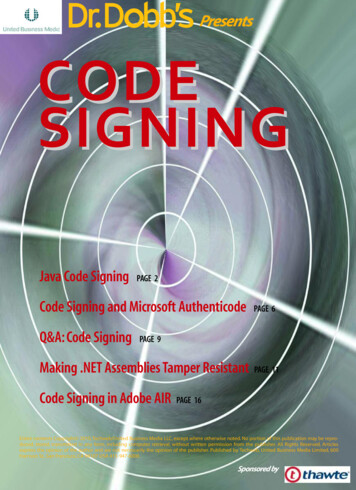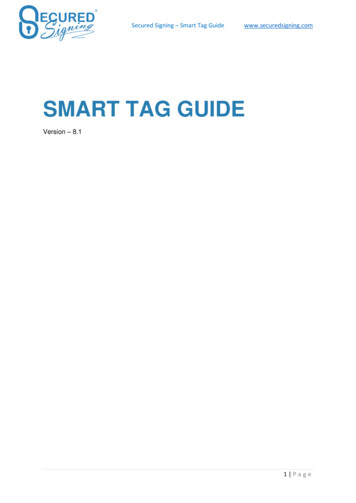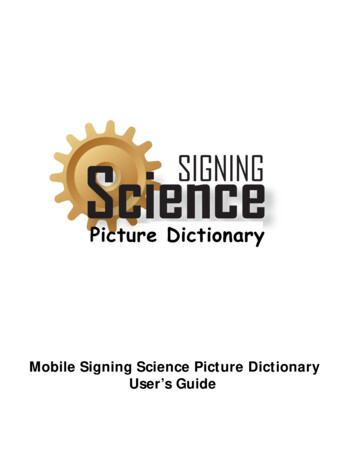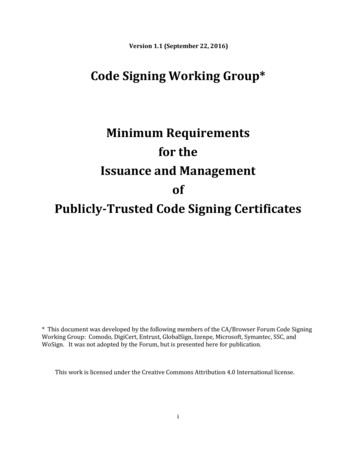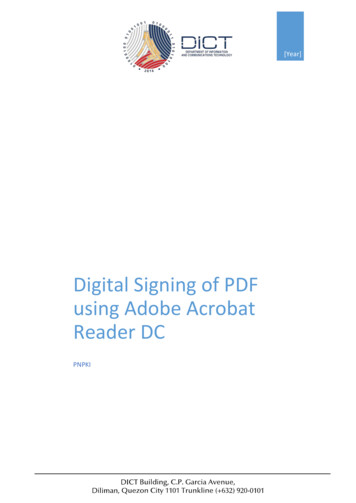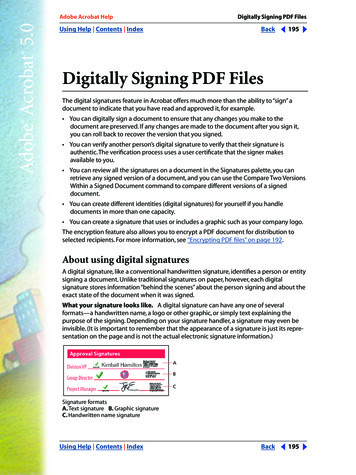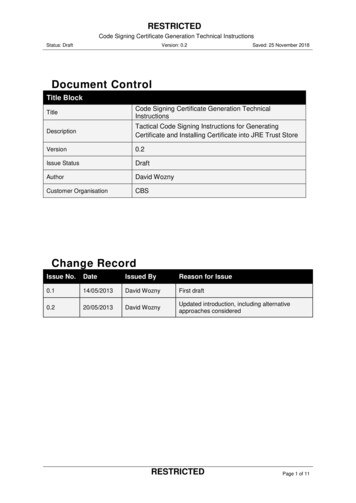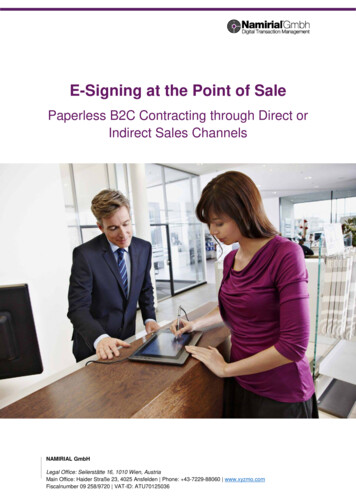
Transcription
E-Signing at the Point of SalePaperless B2C Contracting through Direct orIndirect Sales ChannelsNAMIRIAL GmbHLegal Office: Seilerstätte 16, 1010 Wien, AustriaMain Office: Haider Straße 23, 4025 Ansfelden Phone: 43-7229-88060 www.xyzmo.comFiscalnumber 09 258/9720 VAT-ID: ATU70125036
AbstractIn today’s competitive business climate, it is essential to seek cost-cutting possibilities, toimprove operational efficiency, and to pay attention to customer interests and demands toimprove the bottom line. Printing documents just to capture a customer signature is notonly completely outdated in today’s tablet-pervasive everyday life but also is a great wasteof time and money. More than that, paper handling is extremely time consuming for salesand service personnel and thus reduces the likelihood for efficient customercommunication, which in turn limits up-sell and cross-sell opportunities.Modern e-signature-based digital document processes are now geared up to remedy thesituation, as they are able to close the final gap in the quest to go fully paperless at thepoint of sale (POS). This white paper looks at the specific requirements for such esignature software in typical business-to-consumer (B2C) use cases in both direct saleschannels as they are typically found in today’s bank branches, retail stores, and customercenters and indirect sales channels, such as those operated by agencies and merchants.First, this whitepaper helps you select the most appropriate way to e-sign your digitaldocuments in your POS scenario. After pointing out why you need to look beyond pure esignature capturing toward productivity, we highlight the most important security aspectsyou need to consider. After introducing the pros and cons of various hardware choices forsignature capturing, we show you how to ensure the authenticity of signed documents andhow to prove the validity of documents in case of a dispute. Next, we touch upon the mostimportant topics you need to think about when integrating and deploying the e-signaturesolution into your IT and application environment. Finally, the paper introduces theSIGNificant e-signature platform and outlines a few case studies that show differentimplementations in stationary POS scenarios across the industry.Page 2
Table of Contents1234Selecting the Right Methodology. 41.1E-signing technology. 41.2Document format . 51.3Software architecture . 5More than just Capturing a Signature . 72.1Avoiding incomplete contracts . 72.2Form Fields and Attachments . 72.3Free document edits (annotations). 82.4Allow document reading and editing as if on paper . 8Security Aspects . 93.1Authenticity protection. 93.2Integrity protection . 93.3Limiting access to documents . 93.4Option to verify a signature in real time for the highest process security . 10Devices Options for Capturing Biometric Signatures . 104.1Flexibility to use signature pads from the manufacturer(s) of your choice . 104.2Show the whole document . 114.2.1Signature pads . 114.2.2Signature screens (pen displays) . 114.2.3Multipurpose tablets . 124.3567Using a smartphone to capture biometric signatures . 13Providing Evidence . 155.1Evidence provided by a digital signature/certificate . 155.2Evidence provided by biometric signature data . 165.3Typical server-based audit trails . 165.3.1Action log . 175.3.2Biometric real-time signature verification audit trail . 17Integration and Deployment Requirements . 186.1Standalone GUI App or SDK. 186.2Fast operation in low-bandwidth environments . 186.3Enable thin clients to use USB signature capturing devices . 196.4On-Premise vs. Cloud . 19SIGNificant-References . 207.1Retail banking: GE Money Bank (Czech Republic) . 207.2Retail market: REWE Stores (Germany) . 21Page 3
1 Selecting the Right MethodologyToday, there are quite a few different e-signature solutions for direct and indirect point-ofsale (POS) processes available on the market. While they all allow users to signdocuments digitally, their approaches can be differentiated in the following three keyareas: e-signing technology document format software architectureAs a first step, we want to examine the different available options for each of thesecategories.1.1 E-signing technologyThe most popular e-signature technologies for B2C processes at the POS are: Forensically identifiable signatures (aka biometric signatures) in which the uniquecharacteristics of real handwritten signatures are captured (e.g., speed, acceleration,pressure) that allow for a signature verification by a graphologist. The process ofsigning and signature verification is basically the same as it is with paper-basedsignatures. HTML5 signatures in which signers also sign with their handwritten signatures asthey do on paper. However, e-signing software—due to HTML5 limitations—cannotrecord reliable forensic data, which reduces the traceability of the signature’s image,making an additional user authentication (e.g., one-time password, SMS-TAN, IDverification, etc.) inevitable, which must be included together with the signature insome kind of audit trail. Thus, both the process of signing and the process of signatureverification are quite different from today’s paper-based processes. Certificate-based signatures that require a public key infrastructure (PKI) thatprovides personal digital signing certificates to potential users (e.g., using smart cardsor online access). The signing process here is entirely different from that ofhandwritten signatures (on paper) and is more comparable to passport authenticationat a border or entrance control.In a B2C POS scenario, PKI-based approaches do not work well. One reason might bethat the penetration even of “national ID-cards” – including signature function - is still quitelow, most likely because of the costs and inconvenience of such approaches, especially topeople who are not used to working with the latest technologies. Consequently, one mustexpect that potential clients either do not own a personal signing certificate or cannot/don’twant use it (e.g., because they forgot the access PIN or the smart card that stores thecertificate).Page 4
HTML5 signatures, in contrast, are best suited for B2C processes in which the client needsto sign a document remotely without meeting a sales person face to face because thesesignatures do not require any upfront installation, meaning that clients can easily sign ontheir own devices (e.g., smartphone or PC). In this case, the extra step of authenticatingvia another method different from the pure signature-writing act (e.g., drawing/writing thename) seems to be acceptable to clients.Capturing a forensically identifiable handwrittensignature remains the best choice for gettingdocuments signed in person, in a meeting with thecustomer. Although there are other biometrictechnologies available, biometric signature hasfinally emerged as the de facto industry standardfor electronic signatures in B2C environmentsbecause handwritten signatures are socially widelyaccepted and capturing their biometrical data isseen as nonintrusive for the masses—especially when the signing environment at the POSis preinstalled and thus ready to use and the basic process for a consumer is the same asit is on paper, thus no need to adjust to something new.1.2 Document formatAccording to Gartner Research (Publication ID Number: G00159721) thebest document format is self-contained. Thus it includes the content to besigned, the signature, and the metadata to make it searchable, and itstores the information needed for proof in addition to the signature—which is date, time, and consent in its internal audit log. It should alsoonly require a freely and ubiquitously available reader to show the document in itsoriginally archived form.Other than proprietary document formats and document databases, the open portabledocument format (PDF) fulfills all these requirements. PDF is not only an open standarddefined in ISO 32000-1:2008, but also it comes in a variant designed for long-timearchiving defined as a PDF/A in ISO 19005-1:2005. Additionally, digital signatures are welldefined within the PDF itself (Adobe PDF Reference PDF 32000-1:2008 12.8.3.3 PKCS#7Signatures—as used in ISO 32000), meaning that every standard compliant viewingapplication such as Adobe Acrobat Reader correctly shows digitally signed PDFs. As such,a PDF or PFD/A file is the perfect pendant to paper in the digital world for archiving signeddocument originals.1.3 Software architectureAn e-signing application typically consists of a front-end and a back-end component. Whilethe front-end software manages all user interactions, the back-end software processes thedocument and takes care of its integration into the overall document workflow.The front-end software component naturally runs on a POS computing device, which canbe either a PC or a tablet computer. The back-end software component can run eitherPage 5
locally together with the front-end component inside the same application/on the samecomputer or be split off into a separate server application, which means that the e-singingapplication is distributed over a client and a server.SIGNificant – Architectural OptionsIn many scenarios, the client/server model with a centralized back-end softwarecomponent has many advantages over any e-singing software that is installed separatelyon each local POS computing device. These include: Page 6If existing systems for document creation, workflow management, and documentarchiving are also server-based, the server-side integration is simply much easier.The PDF document is only stored in the secure data center and not automaticallydistributed to the clients, where access to the signed original cannot be securelymanaged.A rich server-side audit trail providing additional process evidenceA server provides a single point and type of integration for all the different clientoptions:o signature pads—managed by a web application or local SDK to be integratedin custom-rich client applicationo signature screens—controlled by a local Kiosk SDK that you can also integrateeasily into a your own Web applicationo smartphones—that run a small signature capture app that connects with aWeb application to view the documento tablets—that run native signing clients to display, edit, and sign documentsCompatibility to additional sales channels—thus reusing the e-singing infrastructureand software integrations already implemented for the POS in a multichannelenvironment that also includes mobile and online channels
In addition, many companies even centralize their front-end software through terminalservice solutions, such as those from Citrix or Microsoft, because they make softwaredeployment and management much easier.In contrast, purely desktop-/local-based signing approaches are typically preferred if: the document to be signed is dynamically created on the client, meaning thattransferring it to the signing server, before processing it on the client, would introducean additional step;server-side integration is not necessary at all;poor network connectivity to the clients, due to a low network bandwidth and highlatency, is a big issue. However, this point can be widely ironed out, e.g., throughlocal document templates, caching and background syncing.2 More than just Capturing a SignatureCompleting a contract sometimes not just involves signing but also potentially entailsediting and filling out the document itself. The more complex this is the higher the chanceis to create an ill-completed contract, which makes a proper guiding highly desirable toavoid a situation in which you discover forgotten signature or form fields after the client hasalready left.2.1 Avoiding incomplete contractsTrying to fix ill-signed contracts afterwards is oftenextremely time consuming and costly because whenyou discover the problem, the client typically is longgone and not easily accessible any more. Thus, it is ahuge benefit if you can control and govern allnecessary steps in the completion and signing processof documents, including filling out form fields, readingimportant clauses, accessing scanners or the camerafor adding attachments such as ID scans, signing onsignature fields, and much more. Ideally, you canspecify compulsory or optional tasks depending on theuse case and document, thus allowing you the flexibilityyou need to best cover all your business cases.Additionally, through defining policies that enable or forbid certain actions on or with thedocument, such as making annotations, saving, e-mailing, or printing documents, you canexercise any required further control.2.2 Form Fields and AttachmentsThus, it is important that the e-signature solutionallows you to fill out form fields such ascheckboxes or text fields and that you can additems such as scanned images or other files (eitherPage 7
as a visible item e.g., on a new page or as an attachment). The data and attachments thenmust be sealed into the document with every provided signature, which ensures that anysubsequent change would be visible in the document. When completing those user actionswith the e-signing software, you can further increase your process evidence (see chapter5.3.1) by logging those user actions into an integrated audit trail.2.3 Free document edits (annotations)It is not always possible to include all information indocuments in advance or to parameterize them via formfields. The e-signing solution must allow you to addannotations - such as specifications - either via atypewriter or with free hand.Other examples are complex contracts that require a moreconsultative approach, in which you want to allow eitherparty to highlight certain key areas (e.g., on a photo),make drawings in the document, or apply last minutechanges to the document. Tools for annotations with freehand or typewriter simply provide you with the flexibilityyou need.2.4 Allow document reading and editing as if on paperIdeally, clients want to work with digital documents in thesame way as they are used to working with paper documents.This means that the e-signing application certainly must allowclients to review multipage documents before signing them—ideally directly on the signing device.With mobile tablets (seechapter 4.2.3), you can easily go beyond this, as they alsoallow editing documents the way you are used to in the paperworld. This includes free hand and text annotations,attachments, and filling out form fields.Also, the integration of the tablet-based signing solution withthe document workflow is key, as you may want to push a prefilled form document (e.g., a client contract) from a POS PC toa specific tablet device, then allow the client to read andupdate its form field values, and sign it. After that, all updatesthe client made to the form field values are saved back intoyour own database.Page 8
3 Security AspectsAs the signed documents are from now on your legally bound originals. Security has to bebulletproof; otherwise, the digital originals become worthless. Therefore, security aspectsare a major topic. The most important aspects are pointed out in this chapter. For moredetailed information, please ask for the SIGNificant security whitepaper.3.1 Authenticity protectionProtecting the authenticity of a signature and its binding to acertain document and position within a document is core to allsecurity aspects of e-signing. It simply must not be possiblefor an attacker to access and copy the signature data of onedocument and paste it somewhere else—whether it be withinthe same document or into a new document. Thus, secureencryption of the raw data—the captured biometricsignature—together with the document fingerprint ( hashvalue) is critical.Here, asymmetrical encryption using a hybrid RSA/AES encryption algorithm is viewedgenerally safe and has been emerged as the de facto industry standard. Today, nearly allimportant signature capture devices (see chapter 4) can perform these asymmetricencryption operations directly on the devices themselves, thus efficiently preventingwiretapping of the biometric signature data.Naturally, proving the document’s signature binding should also not depend on theavailability of the signature-capturing device on which the signature was captured,because signed documents have a much longer time span than the those devices do.3.2 Integrity protectionOnce a document is signed, it is essential that it can easilybe determined whether the signed document is still originalor whether it has been altered after the signature has beenapplied. This kind of integrity analysis must be easilyavailable to everyone who is viewing/reading the signeddocument; otherwise, forging the content of signeddocuments is as easy as it is on paper.3.3 Limiting access to documentsIn contrast to paper, digital files can be easily copied without losing any of theircharacteristics. If a digital file is an original, a digital copy of it creates another validoriginal. In case you want to limit access to an original signed document for securityreasons, you must make sure that the e-signing solution does not simply distribute theoriginal file to all decentralized signing stations—which would significantly increase thecomplexity of securing access to the signed original.Page 9
3.4 Option to verify a signature in real time for the highest process securityIn addition to the deep manual signature verification agraphologist can conduct in case of a legal dispute at any timeafter the document was signed, you can also authenticate asigner in real time – straight after the signing process - anddocument it in a secure audit log (see chapter 5). With thisreal-time signature verification against a pre-enrolledbiometric signature profile database, you can guarantee that adocument or transaction can be signed only by the rightperson. This not only greatly reduces fraud but also dramatically increases the evidentiaryweight. Well-known examples here are client authentication for bank transactions andmanagement/staff authentication for high-value purchase orders.As such, an electronic signature verification system uses all recorded biometric data(speed, acceleration, and pressure), and the false acceptance/rejection rates the system isable to achieve are much better than when simply comparing two or more signatureimages. Important here is that the pre-enrolled profile stays up to date with natural shifts insigning habits over time. In addition, signature capturing has the advantage of lacking theinvasive nature of other biometric authentication methods such as fingerprint, face, orretina scanning. A signature, even if hacked, is not reusable since no one can ever signthe same way twice—signatures are bound to be different from one another. In addition,the signer can always change a signature to create a new personal profile. By contrast,fingerprints etc. do not change (they are static) and may be used again and again.Additionally, some European countries (for example, Italy) even allow this verificationtechnology based on biometric signatures to be used instead of a numerical PIN to accessa qualified personal signing certificate that is stored in a central high security module(HSM). In this case, users can execute a qualified electronic signature (QES) solely withtheir handwritten signature.4 Devices Options for Capturing Biometric SignaturesThe typical business process as a whole for e-signing in branch offices, retail stores, andcustomer centers pretty much differs from use cases in which mobility is a central factor.Consequently, devices are often larger so that they can also show documents moreconveniently. Additionally, other factors such as running advertisements during idleoperation and the possibility of running questionnaires to obtain client feedback is oftencritical. The most important requirements typically found for e-signing at the POS are listedbelow.4.1 Flexibility to use signature pads from the manufacturer(s) of your choiceThe type of signature capturing device that fits best is primarily defined by the specific usecase and environment condition at hand. The market itself offers an extremely broad rangeof devices, including very basic signature pads with a b/w display, signature pads withcolor display, smartphones, pen-enabled screens with a display size of 10” or more, andtablets running iOS, Android, or Windows.Page 10
A device-independent solution offers the necessary flexibility. Thus you can integrate thesolution using the capturing device that fits the needs for each of his use cases best. Thisis best addressed with a modular architecture that enables the introduction of newsignature capturing hardware through plug and play. Ideally, you can even exchange allthe devices you are using today with newer devices released tomorrow without needing toredo your custom integration of the e-signing solution.This enables companies to avoid being beholden to signature hardware manufactures andlets them make an informed decision each time they need to replace the existing hardwareinfrastructure. In addition, market experts foresee a great deal of consolidation and newentries in the signature capture hardware business over the next few years. The likelihoodthat the signature capturing market looks the same as it does now is close to zero.4.2 Show the whole documentMany use cases, and in some countries even the law, require that the signing device notonly display a simple signature box where the client should and does sign, but also thewhole document content too. Displaying the document sector that a signature fieldoverlays as background can be also achieved using black and white signature pads, butbrowsing the entire document and enabling users to read certain paragraphs reallyrequires color devices with good resolution displays.4.2.1 Signature padsIt is already possible to show the document to be signed on a signature pad with a colorLCD of 4–5” given that it provides a high enough resolution. This is basically true for manymodels, including Wacom STU-530, SIGNificant ColorPad 6, StepOver naturaSignFlawless Pad, and so on. To overcome their limited display size, the devices allow you toscroll the document on the signature pad, either autonomously or through communicatingwith the e-signature software running on the host PC (desktop). As outlined in chapter 6.2,the response time of the data transmission has to be considered.4.2.2 Signature screens (pen displays)Signing on pen displays that typically have a size of10” or higher and that are used as a second screenabsolutely requires e-signature software thatmanages them appropriately; otherwise, you willnot benefit from all their strengths. Windows forexample uses the pen display as a desktopextension that uses a stylus as an additional inputdevice. Every time the client touches the screenwith the stylus, the focus is shifted by the operatingsystem to the pen display (second screen),Page 11
disturbing the operator on the main screen. In addition, it’s difficult to train operators todisplay a document that is ready for signing on the screen area of the second (extended)display.One clear advantage of signature screens is their instant responsiveness, which ispleasantly different from the rather slow response time of color signature pads. Screensalso work great for showing videos and high-resolution images, which is excellent forrunning commercials when the screens are idle.However, in a typical setup, you use the signature screen in parallel to the main screen ofthe operator. Moreover, the operator simply might not see what is shown on the signaturescreen. Thus, you need to take care of the following: When the client reviews and signs a document on the signature screen, the operatormust be able to use his or her screen in parallel without being blocked by the client’sinteraction with the e-signing application. Thus, the e-signature solution must preventthe signature screen from grabbing the mouse focus from the main screen. What is shown on the signature screen versus the operator screen needs to be fullyautomated because having to move application windows around manually on twodifferent screens is simply too big a hassle. The operator should see what the clients are doing on their signature screens,allowing the operator to guide and assist the clients by using a monitoring windowon the main operator screen. Interactive screens are great for collecting customer feedback. Therefore, the esignature solution should be able to present surveys to the client and collect theanswers after customers have completed the transaction. When the signature screen is in idle mode, it should show predefined ads such aspresentations or. This advertising mode should not interfere with other applicationsrunning in parallel on the operator’s connected computer.4.2.3 Multipurpose tabletsMobile tablets such as the iPad, Galaxy Note 10, or Surface Pro are primarily built for amobile use case. However, as they can be used for multiple purposes, provide a ratherlarge screen that allows comfortable display of full page documents, are fairly cheap owingto their mass production, and are easily available, mobile tablets are also very interestingfor a point-of-sale process. If the sales agent does not work off a fixed desk but has to besomewhat mobile, these tablets are even more useful.An additional advantage is that these multipurpose devices can be turned into biometricsigning devices through a native application that can also be used to cache data, makingthe devices independent from network connections, bandwidth issues, and/or slow serverresponse times (see chapter 6.2). Additionally, they are ideal if you want to allow users towork with documents like on paper, as described in chapter 2.4.Page 12
Furthermore, it is highly beneficial if the signing application on such tablet devices is tightlyintegrated with the overall e-signing solution, which can also be used with other signaturecapturing devices such as signature pads and screens. Only then is a mixed infrastructurethat includes switching between signature pads and mobile devices, depending on the use4.3 Using a smartphone to capture biometric signaturesSmartphones, meanwhile, have achieved incredibly impressivemarket penetration. Nearly everyone has one. As such, why notuse them for capturing handwritten signatures and their biometricdata—especially in situations where you cannot equip thesalesperson with special purpose signature pads, screens, ortablets? You may not want to equip independent sales agencieswith such devices, but you can count on every salesperson in that organization having asmartphone that can be used for signature capturing—so let’s use them.All you need to do is providing a small biometric signature capturing app on thesmartphone that is compatible with the back-end component of your e-signature software.Simply sign with a capacitive stylus, a finger, or with the native pen should the smartphonecome with one.The typical process includes the following: Review documents or complete form fields and then add attachments on anycomputer in
documents signed in person, in a meeting with the customer. Although there are other biometric technologies available, biometric signature has finally emerged as the de facto industry standard for electronic signatures in B2C environments because handwritten signatures are socially widely accepted and capturing their biometrical data is




